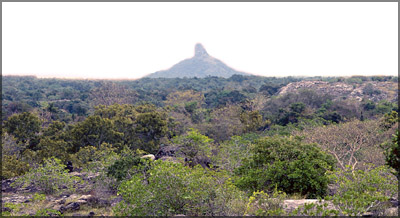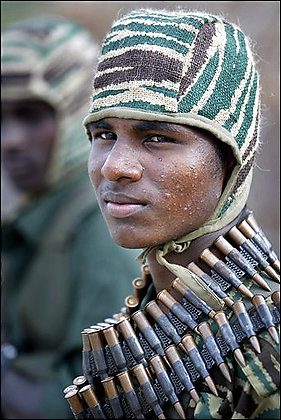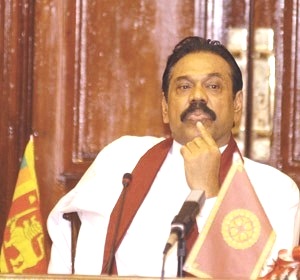Ilankai Tamil Sangam30th Year on the Web Association of Tamils of Sri Lanka in the USA |
|||
 Home Home Archives Archives |
Will Tamil Kudumbimalai Be Turned into Sinhalese Thoppigala Soon?by D.B.S. Jeyaraj, FederalIdea, July 14, 2007
It is a rocky mountain with a stony peak and a kind of mini - peak on top! Such an appearance from afar lends itself to differently imagined perceptions. To the English authorities it looked like aristocratic head gear. So it was Baron’s cap; to the Tamils it was like a tuft of bound hair on one’s head. So it was Kudumbimalai; to the Muslims it was like a hat on one’s head. So they called it Thoppikkal; the Sinhalese also perceived it like the Muslims. So they called it Thoppigala. I saw it for the first time in 1977 when I was travelling in a vehicle with the late Sam Thambimuthu along a dirt track to Vadamunai.. Sam was a leading lawyer and stalwart of the Federal party and later the Tamil United Liberation Front (TULF)in B’caloa. Sam was legal secretary of the TULF then He was married to Kala, daughter of former FP senator Manickam. Sam was later to become EPRLF Parliamentarian for Batticaloa in 1989. Both he and his wife were killed by the LTTE in 1990 as they came out of the Canadian High Commission in Colombo. A large number of Plantation Tamils had moved to the East after being uprooted from the Up - Country by land reform and communal violence. Various Batticaloa organizations were running rehabilitation and re- settlement reports. I was working as the “Virakesari” staff correspondent for B’caloa then. I used to accompany people like Sam Thambimuthu or Dr. Rajan Chellaiah on trips to these projects in places like Panichankerny, Aayithiyamalai, Karadiyanaaru. Marappaalam, Periyapullumalai etc. It was on such a trip that I saw Baron’s cap.
[Kudumbimalai /Thoppigala - Barons Cap: Pic: Daily News.lk] The region surrounding Kudumbimalai/Thoppigala was populated sparsely. There were Tamils, Muslims and Sinhalese. There were age old settlements called puranagama or puranakamam there. Most of them were centered around natural lakes called “villus”. These are depressions in the land filled by rain water. Some of the ancient villages were Kallichenai, Oothuchenai, Meerandavillu,Keeraniavillu, Kathavanai, Maha - Eliya etc. I think Kallichenai , Oothuchenai and Meerandavillu were Muslim villages while Maha - Eliya was Sinhala. The others were Tamil. The different communities were living in great harmony. There was much inter - marriage between Sinhala and Tamil communities. Both communities spoke each others language to some extent.Some Tamil and Sinhalese women married Muslims and converted to Islam but would wear their traditional clothes and jewellery and also maintain links with their kith and kin. Many of the farmers belonged to the dying breed of chena cultivators. There was a lot of dairy farming in the region. Large herds of cattle would graze in the plains and grassy highlands. They were owned by absentee livestock owners both Muslims and Tamils. Their henchmen lived in the area as eastern “cowboys”. The Vadamunai scheme was comparatively new. It was first started for Tamils driven away from the Gal Oya Valley in 1956 and 1958. Later Plantation Tamils uprooted in the seventies during Hector Kobbekaduwe’s land reform also came here. In 1977 more Plantation Tamils affected by the August violence were settled here. My trip to Vadamunai with Sam was to see such a settlement coordinated by a dedicated B’caloa youth called “Bobby”. All these memories are revived as the area is now in the news. Sadly the mountain and region is not having publicity due to its natural diversity or ethnic harmony but because of its so - called strategic importance in military terms. Even as the ethnic escalation escalated this little - known area in the remote Eastern province has acquired an importance exceeding that of its actual relevance. The Britiish being our colonial masters then the mountain was officially Baron’s Cap even after Independence. Official records would refer to it as Baron’s cap and some as “gap”. But to the people of the area it was Thoppigala, Kudumbimalai or Thoppikkal. There was a large forest around the mountain that was officially declared as a forest reserve. I think the total area was around 350 - 400 sq Kilometres. Almost adjoining it was the Undugala forest reserve. These areas are called the Kudumbimalai /Thoppigala region. The region was roughly a triangle with Vadamunai, Barons cap and Tharavaikulam being the three outlying points. To the West is the Maduru - Oya basin catchment area;To the South and East is the Maha - Oya - Chenkalladdy road; to the North is the Polonnaruwa road; Further to the North west is Vaahaneri tank. The Vadamunai - Kudumbimalai - Tharavai region evolved in recent years as a stronghold of the Liberation Tigers of Tamil Eelam (LTTE). This happened in the late eighties and nineties when Vinayagamoorthy Muraleetharan alias “Col” Karuna was Eastern regional commander of the LTTE. Among structures set up here was “Meenagam” the military headquarters base’ The political headquarters “Thenagam” was in Karadiyanaaru. Tharavai was the cemetery for tigers fallen in the battlefield. They are known as “Maaveerar thuyilum illam” or “abode of rest for great heroes”.. The region’s remoteness made it virtually inaccessible. With its forests, fields,plains, waterholes, hills and rocks the region provided much cover. Though a number of structures were set up here the LTTE has at no time in the past under Karuna adopted positional warfare to retain territory. During Karuna’s time the tigers always melted away into the forests if and when the security forces invaded. This was the situation when the Indian army entered the region too. The guerillas never fought back like a conventional army to retain the region under Karuna. They simply fled and returned after the enemy went away. Neither the Indian nor Sri Lankan army remained for long in the region. They did not set up permanent bases but returned to nearby positions. Interestingly Karuna did not try to hold on to this region even when the split occurred in the LTTE. Everyone expected Karuna to fall back to Kudumbimalai and fight a last ditch stand after the defeats in Verugal - Kathiraveli - Vaakarai at the hands of the mainstream LTTE in April 2004. But he did not. Even more interesting was the fact that the mainstream LTTE too did not try to maintain a large, permanent presence in the region after the Karuna revolt. For reasons best known to them the tigers shut down the “Meenagam” base and dismantled structures. Some of the construction material and furniture were given to Tamil peasant families as charity. The LTTE also stopped burials at Tharavai and began using Thandiaddy near Kokkaticholai as their burial grounds. All this shows that the LTTE had been gradually downsizing their reliance on the region. It was in recent times that the LTTE began to utilise the region more. Once the LTTE began withdrawing from Trincomalee South and then Vaakarai region and then the Paduvaankarai region the bulk of the cadres began re- locating to the Northern mainland of the Wanni. The remaining cadres began moving into the Vadamunai - Kudumbimalai - Tharavai region. There were reasons for this. One was that recent developments had revived the importance of the “Beirut trail” again. The “Beirut trail” is a loose term refering to adhoc jungle routes followed by cadres travelling to and from the North. Let it be remembered that there was a time when the LTTE did not control extensive swathes of territory. The LTTE also did not have a well - developed sea tigers wing in the not so distant past. It was not possible for tiger boats to ferry eastern tigers to the north and vice versa easily. So much of the North - East movement was on foot. The tigrs used to travel through jungle routes. The journey commenced from the Kudumbimalai jungles to Vaahaneri. Travelling northwards the Veruhal river was crossed. Then they moved through jungles near Kiliveddy, Maavilaaru, Serunuwara, Kinniya , Kadavanaikulam, etc into the Manalaaru /Weli ya region and further towards North. It was an ardous and difficult journey but the tigers used the “Beirut trail” frequently. As time progressed and the LTTE acquired much sea power and also expanded territorial control the Bbeirut trail” went out of mode. Tigers would get into boats at Vaakarai or Paalsenai or Verugal or Ilakkanthai and land at Mullaitheevu via the sea. Likewise tigers from the North would travel to east also by sea. But in recent times the LTTE has lost control of the Eastern coast right down to Panichankerny in Batticaloa from Sampoor in Trincomalee. With sea movement becoming restricted the land route of “Beirut trail” was re - activated again. This enhanced the importance of the Kudumbimalai region. Another reason for the region’s recent importance was the fact that it offers the best possible “cover” for classic gueriila warfare. The Vadamunai - Kudumbimalai - Tharavai region provides natural cover to a great extent. It is possible for small groups of guerillas to move about in the region and conduct occasional forays. It appears that the LTTE is now transforming itself in the East from positional warfare to gueriila tactics. The LTTE sent its last major batch of guerillas fom the East to North some weeks ago. More than 300 cadres went back with Col. Ramesh.The LTTE also managed to transport most of its military assets too . Still more than 200 cadres are still left in the region.Ram, Nagesh, Pallavan, Keerthi, Mano master etc are all in the region with small groups of gueriilas. All of them are eastern sons of the soil. Col. Jeyam a northerner is also in the region. He commands an elite group of special commandos. The LTTE has also sent most of its new recruits and conscripts back. Married cadres have also been sent back. Most of the women cadrs have gone to the Wanni.
[A Tamil Tiger fighter at a training camp in an undisclosed location deep in Tiger controlled territory, northeast of Colombo, Sri Lanka, Friday, July 13, 2007. (AP Photo/Gemunu Amarasinghe)] Reports indicate that the LTTE did not resist military advances fiercely in recent times. They allowed the army to advance and then launched counter attacks. After some time the LTTE suddenly withdrew to positions west of Baron’s cap. Thus the field was clear for the security forces to move forward and raise the flag of conquest. What is important to note is that the region is not bereft of tigers. Another point is that the LTTE has managed to withdraw in large numbers using the virtually extinct “Beirut trail”. Furthermore the territory is extremely porous and cannot be sealed off. So future exfiltration and infiltration of LTTE cadres cannot be prevented. Against this backdrop the region does not require a strong, permanent military presence to control it. Such control is not possible. The cost - effective method is to “dominate” the region by conducting frequent patrols, search operations and limited ground offensives. This is why the Indian Army never established a permanent presence. This is why generals like Lucky Algama or Janaka Perera also refrained from doing so while in the East. Despite Janaka Perera’s “controversial” record in certain spheres there is no denying that he was the most “intellectual” of Sri Lanka’s top soldiers. As for Algama he proved himself by clearing the East successfully in mid - nineties to conduct safe polls. It is in this context that the strategic importance of the Kudumbimalai/Thoppigala region is being questioned publicly. Retired Indian general Ashok Metha did so. Military intelligence (retd) Chief Col .Hariharan has done so. Several UNP leaders have done so. All of them are being severely criticised by Govt circles. The Indian army is being ridiculed as being incapable of capturing Kudumbimalai whereas the Sri Lankan forces are capable. Schoolchildren are being “educated” that the battle for “Thoppigala” was the mother of all battles and the victory at Thoppigala is the single greatest achievement of the armed forces after Dutu Gemunu. Speaking of Dutu Gemunu his armies marched through this region to engage Elara at Anuradhapura. Several Tamil feudal chiefs from the East joined Dutu Gemunu’s army with their men. Though the “Ellaalan - Thuttakaimunu” battle is depicted as a battle between Sinhala and Tamil races it was not so in actuality. It was more a power struggle between a young Sinhala Prince and an old Tamil monarch. The armies of both had members from both ethnic groups. History is being repeated now as the eastern Tamil warlords like Karuna, Pillaiyan, Iniyabharaty and Mangalan master etc team up with a Sinhala President to defeat LTTE’s Tamil national leader. The current victory in Kudumbimalai./ Thoppigala is not to be underestimated. It cannot be pooh - poohed as insignificant. At the same time it cannot be overblown , disproportionately as a great victory either. Also the strategic importance of the region cannot be exaggerated out of proportion simply to project an impression that a magnificient victory has been achieved.
[President Mahinda Rajapakse] The plans afoot to have a big”tamasha” to celebrate the victory is done with ulterior political motives. An undisguised attempt is being made to create a larger than life, latter day “Dutu Gemunu” image for Mahendra Percival Rajapakse. To what extent these cheap manouevres would succeed remains to be seen. Also one effective counter strike by the LTTE could deflate this overblown “gas” balloon. There could however be a hidden agenda in the Rajapakse regime’s unseemly interest in consolidating a greater hold on the Kudumbimalai/Thoppigala region. If it was merely from a military angle then a permanent presence is unnecessary. But there could be other reasons. One pecuniary reason could be the vast timber resources available. It is very possible to chop trees and transport timber from the region using the security force apparatus. Even suggesting such a thing would have been treated as blasphemy in the old days. It’s not so nowadays. In a land where top security people are “suspected” of running an abduction for ransom racket these things are feasible. Anything is possible in a Country where money was allegedly paid to one’s chief enemy to ensure electoral victory. The other motive could be dangerously counter - productive in political terms. It has been a fervent dream of certain Sinhala chauvinists to colonise Tamil and Muslim areas with Sinhala settlers. This dream is now becoming a reality under the Rajapakse regime. Recent events in Tribcomalee and Pottuvil denote this growing trend. Given recent history it is quite probable that a permanent. strong military presence is being set up to facilitate Sinhala colonisation of the Kudumbimalai region. The possibility is not far - fetched in view of what happened more than 20 years ago. It was in 1983 that the Ven. Kithalagama Seelankara Thero (Dimbulagala thero) organized an illegal, “Colonisation” attempt in the region. The controversial Bikku was implementing a plan devised by people like Gamini Dissanayake, NGP Panditharatne and Herman Malinga Gunaratne. Around 40,000 Sinhala settlers were taken in Mahaveli Authority vehicles and dropped in the Vadamunai- Kudumbimalai - Tharavaikulam jungles. Finances were provided by the Mahaweli development ministry and Sinhala businessmen. Armed security was provided by ex - navy personnel. Most of them had been “fired” from the navy for engaging in communal violence against innocent Tamils in Trincomalee during July 1983. In fairness to President JR Jayewardene he was in the dark about this sordid exercise. When an international outcry led by India and Canada ensued a beleaguered Jayewardene was frantic. Besides the gentle Tamil Minister KW Devanayagam was uncharacteristically tough on this issue and pressured JR strongly.. The “occupied” lands came under Kalkudah his electorate. When questioned Dissanayake underplayed the issue saying only around 5,000 settlers had converged on their own volition. Jayewardene sent his trusted nephew Ranil Wickremasinghe by helicopter to ascertain the truth. Ranil reported back truthfully that 40,000 persons aided by Mahaweli personnel were squatting illegally. This led to a major showdown in cabinet between Wickremasinghe and Dissanayake. Both Panditaratne and Dissanayake declined to dismantle the project. So JR appointed Kaduwela MP and lawyer Paul Perera as Polonnaruwa district minister and deputed him to handle the issue. Perera with the assistance of some ex - army officers adopted “unofficial” rough tactics to drive away the illegal squatters. Thus ended that drama. But now those plans could be revived. What was an adhoc, unofficial attempt then could become a well - planned official exercise under the Rajapakse regime. The new “Naginahira Navodhaya” scheme for Eastern resurgence could have a few such projects on the agenda. For successful settlement a strong military presemce is essential. A similiar exercise as done in the Manal aaru/Weli - Oya region could be undertaken in the Kudumbimalai - Thoppigala region. When the battle for Sampoor commenced this columnist warned of plans to set up a High security zone in Sampoor and Moothoor East. I predicted that the dispersed people would not be allowed to go back to their residences. This has now become a harsh reality. Likewise the Rajapakse regime could go ahead with such plans for Kudumbimalai unless checked now. If no action is taken by interested parties despite advanced watnings then a re - play of Sampoor is very likely. If that happens the region South of Trincomalee district could become a “buffer” as in the case of the region north of the same district. Lands in Mullaitheevu, Vavuniya and Trincomalee districts were appropriated and a new region created to interdict Northern and Eastern territorial contiguity. The Tamil inhabitants were driven away in a flagrant exercise of ethnic cleansing. There “Tamil” Manal aaru became “Sinhala” Weli - Oya. Here”Tamil” Kudumbimalai could become “Sinhala” Thoppigala. The signs are already there. The media are full of references to “Thoppigala”only. The Tamil name “Kudumbimalai” is nowhere to be seen! |
||
|
|||


